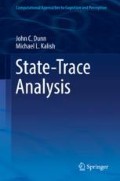Abstract
We describe the inductive problem of determining the dimensionality of a latent structure. We show that induction is impossible without some restriction on the form of the output mapping. We argue that monotonicity is the weakest sufficient constraint. First, monotonicity strikes an appropriate balance between generality on the one hand and tractability on the other hand. Second, while it may be desirable to adopt a more restrictive assumption than monotonicity, in most situations this cannot be justified. This problem is not peculiar to psychological science but is a case of the general problem of nomic measurement that affects all branches of science. We illustrate the problem of nomic measurement, and clarify why monotonicity is a reasonable practical solution.
Access this chapter
Tax calculation will be finalised at checkout
Purchases are for personal use only
Notes
- 1.
We exclude for the present the hypothesis that dim(LV space) = 0 where the state-trace consists of a single point in DV space.
- 2.
If x is a linear function of u and y is a linear function of u, then y is a linear function of x and vice versa.
- 3.
That is, defining a testable property of the state-trace that identifies it as an element of Q.
- 4.
This assumes that c ≤ d.
- 5.
As it turns out, mercury and many other substances, including water, do not expand linearly with temperature. Hence the need for careful calibration.
- 6.
Although different interpretations are possible. For example, one latent variable may correspond to memory for mono-oriented objects and the second to the difference between this and memory for faces.
- 7.
This is quantified by a constant known as the thermal expansion coefficient which is about 3.5 times greater for alcohol than for water—which is why alcohol is used in thermometers instead of water.
References
Ashby, F. G. (2014). Is state-trace analysis an appropriate tool for assessing the number of cognitive systems? Psychonomic Bulletin & Review, 21(4), 935–946.
Beattie, J. A., Blaisdell, B. E., Kaye, J., Gerry, H. T., & Johnson, C. A. (1941). An experimental study of the absolute temperature scale VIII. The thermal expansion and compressibility of vitreous silica and the thermal dilation of mercury. Proceedings of the American Academy of Arts and Sciences, 74(11), 371–388.
Chang, H. (2004). Inventing temperature: Measurement and scientific progress. New York: Oxford University Press.
Dunn, J. C., Kalish, M. L., & Newell, B. R. (2014). State-trace analysis can be an appropriate tool for assessing the number of cognitive systems: A reply to Ashby (2014). Psychonomic Bulletin & Review, 27(4), 947–954.
Laguesse, R., Dormal, G., Biervoye, A., Kuefner, D., & Rossion, B. (2012). Extensive visual training in adulthood significantly reduces the face inversion effect. Journal of Vision, 12(10), 1–13.
Loftus, G. R. (1978). On interpretation of interactions. Memory and Cognition, 6(3), 312–319.
Loftus, G. R., Oberg, M. A., & Dillon, A. M. (2004). Linear theory, dimensional theory, and the face-inversion effect. Psychological Review, 111(4), 835–863.
Reif, F. (1965). Fundamentals of statistical and thermal physics. New York: McGraw-Hill.
Valentine, T. (1988). Upside-down faces: A review of the effect of inversion upon face. British Journal of Psychology, 79(4), 471–491.
Wagenmakers, E.-J., Krypotos, A.-M., Criss, A. H., & Iverson, G. J. (2012). On the interpretation of removable interactions: A survey of the field 33 years after Loftus. Memory & Cognition, 40(2), 145–160.
Wagenmakers, E.-J., Ratcliff, R., Gomez, P., & Iverson, G. J. (2004). Assessing model mimicry using the parametric bootstrap. Journal of Mathematical Psychology, 48(1), 28–50.
Yin, R. K. (1969). Looking at upside-down faces. Journal of Experimental Psychology, 81(1), 141–145.
Author information
Authors and Affiliations
Rights and permissions
Copyright information
© 2018 Springer International Publishing AG
About this chapter
Cite this chapter
Dunn, J.C., Kalish, M.L. (2018). Monotonicity. In: State-Trace Analysis. Computational Approaches to Cognition and Perception. Springer, Cham. https://doi.org/10.1007/978-3-319-73129-2_2
Download citation
DOI: https://doi.org/10.1007/978-3-319-73129-2_2
Published:
Publisher Name: Springer, Cham
Print ISBN: 978-3-319-73128-5
Online ISBN: 978-3-319-73129-2
eBook Packages: Behavioral Science and PsychologyBehavioral Science and Psychology (R0)

